If you will come across the question, what do jellyfish eat and how do they eat. That is why we have gathered a detailed article to clear up your doubts
In the animal world, we find lots of interesting stuff about different kinds of animals.
Among them, some animals catch our attention because of their special features. Jellyfish are one such animal species with so many peculiar characteristics.
Jellyfish do not technically have typical mouths that can catch food. But, like any other animal, they also require food to survive.
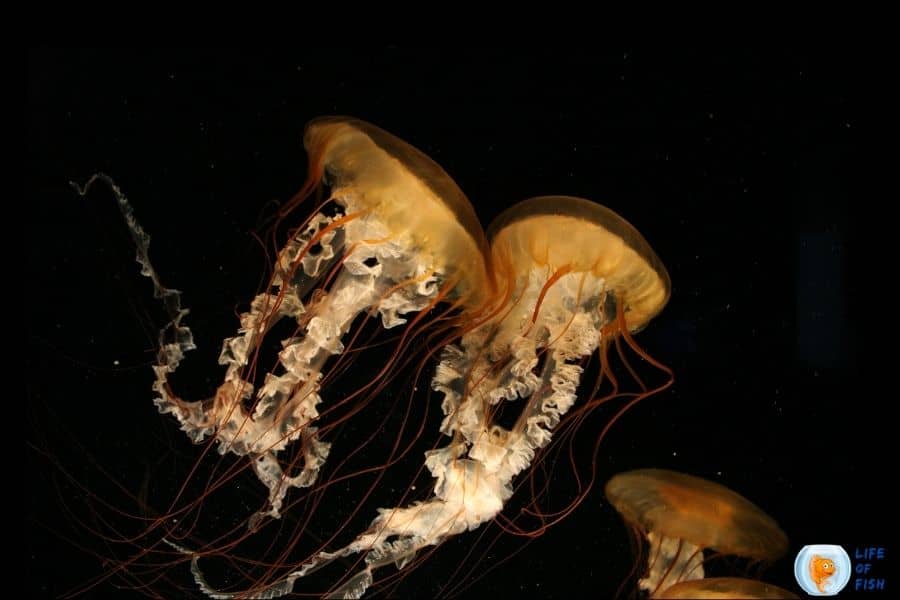
What do jellyfish eat?
Jump To
Jellyfish come in various sizes. There are about 200 known jellyfish species sized from one centimeter to 36 meters.
So, different-sized jellyfish eat different food. But, generally, all jellyfish species are carnivores.
To get a broad idea about what do jellyfish eat, let’s categorize them into two groups; large and small. Though different jellyfish species consume different food depending on their size, this categorization will make it easy to understand everything in simple terms.
The Diet of Small Jellyfish
The small jellyfish diet consists of tiny organisms that float in the water. These include,
- Zooplanktons
- Fish eggs
- Shrimp eggs
- Shrimplets
- Larvae
- Tiny fish
- Brine shrimp
- Plants and
- Many other tiny creatures
When jellyfish are multiplied by millions in an area, it is called a Jellyfish bloom.
It is hard for small fish to find any food in such places because jellyfish eat almost everything small and have nutrition around the area.
So, small fish will have to leave the site and find food somewhere else.
But, this is not a problem though, as fish are more intelligent and can search for food elsewhere.
Jellyfish will not follow fish as they have no brain, thus aren’t smart. All they can do is float around and eat everything that comes near their tentacles.
Jellyfish can not search for food, to be precise.
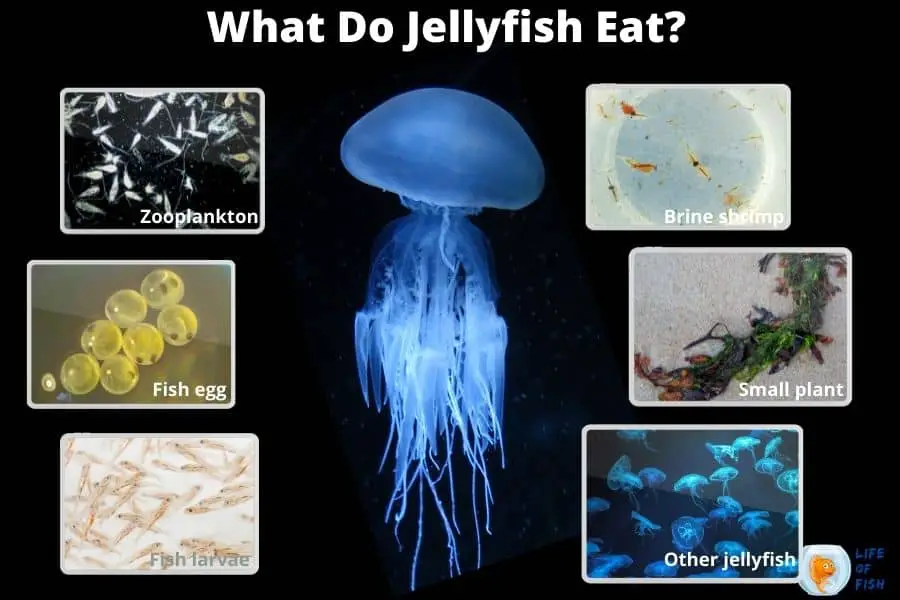
Diet of Large Jellyfish
The diet of large or adult jellyfish also is similar to small jellyfish. The difference is, their meals are larger.
Larger jellyfish also eat what comes near them, just like smaller jellies. They also do not search for food intentionally.
However, when prey is near their tentacles, they paralyze their prey with poisonous stings. Because of this, they can actively capture and kill aquatic animals.
All Jellyfish species have 4 to 8 tentacles that consist of stings in each tentacle.
When prey is nearby and accidentally touches one of the tentacles, large jellyfish immediately sting the prey with toxins and paralyze the animal.
Then it directly brings the prey with oral arms towards the mouth below the bell and eats it.
The size of the prey will always be smaller than the size of the jellyfish’s mouth. If the animal is larger, the jellyfish may not be able to consume it.
Some marine animals that become jellyfish’s prey are,
- Lobsters
- Shrimps
- Small fish
- Barnacles
- Crabs
- Plants and
- Other Jellies
- Fish eggs
- Brine shrimp
Yes. They also eat other jellyfish, even their own species, when given a chance.
So, actually, jellyfish have cannibalistic behavior. Although they eat their own species, they do not have any idea about what’s coming into their mouth.
This is because they do not have the brain to think about what’s going on around them. Therefore, they have to graze on anything that floats by.
Jellyfish do have a super simple digestive system. But they can consume a wide variety of food. So, jellyfish will eat whatever that comes by to keep going on.
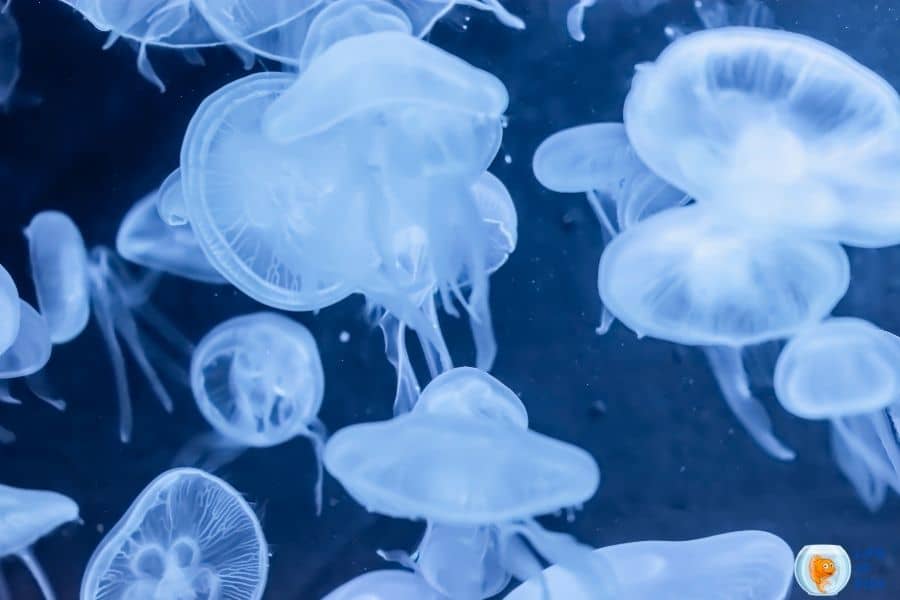
How do Jellyfish eat?
Unlike typical fish, jellyfish have a different mechanism for catching and eating food.
In short, they will catch edible organisms with their long tentacles and sting them to paralyze them. Then their oral arms bring the food to the mouth to consume.
Still, things are unclear? We will explain more.
As we said before, jellyfish do not intentionally search for food because they don’t have the brain to think.
What they do is passively float (with ocean currents) around the water. While floating, they will come across edible marine animals and feed them when they touch jellyfish.
These creatures do not have brains, so it depends on the water flow and their sensitivity to feed.
Let’s dig in deeper.
How does a jellyfish get food to eat?
There are five basic steps of the jellyfish feeding cycle.
- Food catching
- Food transporting
- Eating
- Digesting and
- Emptying the bowel
This may seem simple as every animal we know does all of them, even us. But, the way Jellyfish does it is entirely different.
Food catching ( Where tentacles do their job)
Jellyfish have tentacles just to catch prey.
The tentacles of jellyfish are covered with stinging cells called nematocysts that can discharge venom.
This venom can immobilize, even kill small organisms like fish, shrimps, and crabs. They hang down from their body and float around while the jellyfish floats around.
In some jellyfish species, these tentacles reach up to 100 feet. So, all the animals near these tentacles are at risk of getting eaten.
When zooplanktons and other small animals pass by these tentacles, they may accidentally get in contact with the tentacles.
If this happens, they immediately get poisoned by nematocysts and get paralyzed because of the venom. The small creature may eventually die as some jellyfish contain deadly poison.
Some bigger jellyfish species even have a stinging thread that can throw out towards their prey.
Food transporting (Oral Arms time)
The tentacle’s job is to catch and paralyze the prey so that jellyfish can eat it.
But, they need a way to transport the food to their mouth. This is where the oral arms of jellyfish come into action.
Oral arms are usually shorter than tentacles. They can actively grab the prey and move it the rest of the way to the mouth.
What oral arms do is, capturing the paralyzed animal and transporting it to the mouth.
Eating ( or swallowing? Maybe)
jellyfish swallow or eat the food once the oral arms bring that food into the mouth.
Jellyfish Mouth
Jellyfish mouth is placed below their bell and looks mostly like a small hole. Most jellyfish species do not have teeth, but some have such as beroid comb jellies.
These teeth are made of tiny “hairs” that can pierce, tear and pull the prey into the stomach.
This mouth can do basic things like consuming food, directing it into the stomach, and shooting water to move forward.
So, the mouth is an essential organ of jellyfish because it also is in charge of moving the animal around.
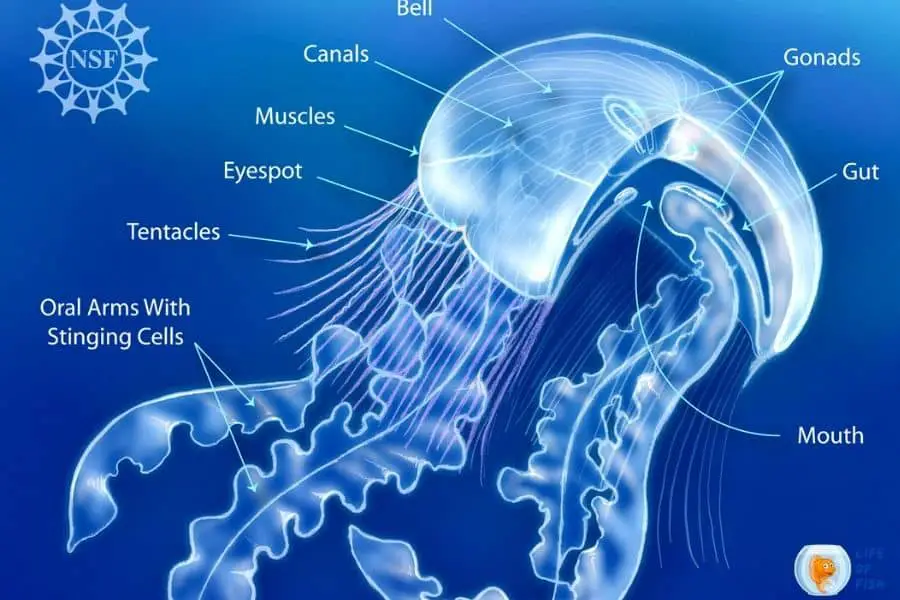
Digesting
Jellyfish have a straightforward digestive system. When the food enters through the mouth, it ends up in the stomach immediately.
Its digestive system is so simple that it doesn’t have a liver, pancreas, or intestines.
Their digestive system works differently rather than other animals. They have an organ called the coelenteron that helps with the digestion of food.
This is simply a cavity with a single opening that can enter food and expel waste.
This organ consists of powerful enzymes that can break down the food approximately in 15 minutes.
The coelenteron not only digests food but also exchanges gas and water between the jellyfish’s cells.
Because the jellies contain no blood and veins, there is no functional circulation system in their body.
Emptying the Bowel
When an animal eats and digests food, it has to expel the waste through its butt. But, these fellas do not have a butt.
Wait what?
Yes. You heard it right. Jellyfish do not have an anus. So, the debris has to get out the same way that food came in; through its mouth.
This is another task that is assigned to the jellyfish’s mouth. When the food is finished digesting, the waste comes out through the mouth. Then the coelenteron gets empty to digest the next piece of food.
What is interesting is that this process happens so fast as about 15 minutes maximum.
But this makes sense because they often get to eat only tiny stuff, so there is not much to digest anyway.
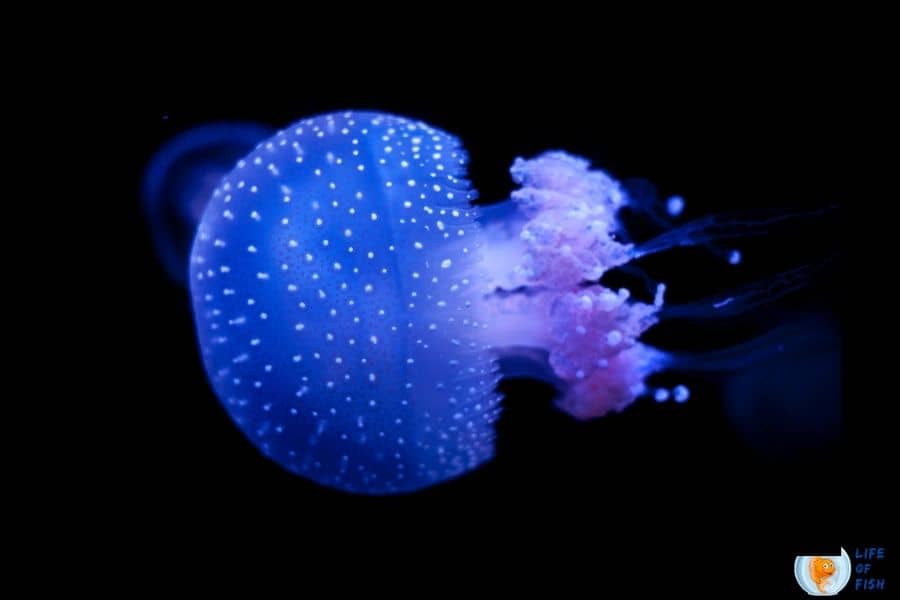
Who eats jellyfish?
Although jellyfish contain venom in their tentacles, they also become prey for some animals. Some sea animals that eat jellyfish are,
- Sea Turtles
- Spadefish
- Butterfish
- Spiny dogfish
- Sunfish
- Tuna
- Other Jellyfish
However, the decline of these sea creatures caused jellyfish to multiply rapidly and create jellyfish blooms in some parts of the world.
Some jellyfish species like Cannonball jellyfish and the blue blubber jellyfish are consumed by humans, especially in some Southeast Asian countries such as China, Thailand, and Japan.
People in these countries consider these Jellyish as delicacies and serve dishes at higher rates.
So, they have become excellent export seafood in the U.S. State of Georgia. They are being dried and packaged before being transported.
According to Wikipedia, Mexico harvested 20,000 tons of Cannonball jellyfish (equal to US$3.5 million) in 2012 in just three months.
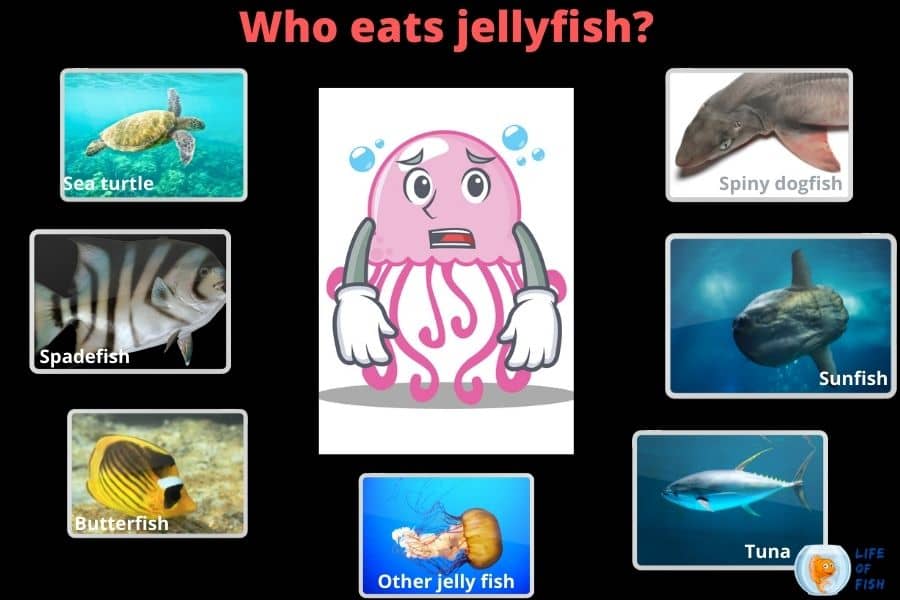
Related Questions
How long do jellyfish live?
Most jellyfish species live for up to one year, while some species live for more than 100 years.
One such species is Turritopsis dohrnii, also known as the immortal jellyfish. This jellyfish is actually biologically immortal.
Immortal jellyfish medusas can actually turn back to polyps under challenging conditions such as starvation, reduction of salinity, sudden temperature changes, and accidents to survive.
It is considered one of the longest living animals in the world. But some smaller jellies only live for few days.
Are jellyfish toxic to humans?
All jellyfish sting contains poison. However, only the venoms of some jellyfish species are toxic to humans.
Some jellyfish species such as Chironex Fleckeri, Chiropsalmus Quadrigatus, Irukandji, Morbakka Fenneri, and Alatina Alata contain venom that can be deadly to humans.
But, many other jellyfish species will only cause you some swelling or itching at most.
Are jellyfish edible?
Although some jellyfish species are dangerous to humans, others are safe to eat.
Among 200 known species of jellyfish, about 11 jellyfish species are identified as edible for human consumption.
For example, Rhopilema esculentum is a popular edible jellyfish species in Southeastern Asia.
Many edible jellyfish are dried and powdered for use in soups, and some others are served as expensive dishes in these countries.
Read Next: Blue Blubber Jellyfish | 9 Important Care Secrets
